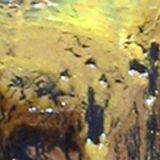Arctic Pigments
Arctic Pigments Can Make Your Paintings Glow
By: Prof. Gulley Jimson, RA, Ph.D., AFT, RCA, PADI
Hello again, dear fans of all things Jimson.
Welcome to another of my irregular posts on Art Twerks.
In this installment, I have yet more wonderful news for all you art lovers, and especially those of you who lust and drool for rare and unique pigments. For instance, we all know where the best shade of pink is to be found. Hee hee…
Since my return from the Arctic region, I am still shivering as I write this latest report. “Why go to the frigid Arctic?” you may ask. Because one of my reliable sources told me the melting ice packs up north have yielded newly discovered mineral deposits that contain previously unknown pigments.
Fortunately, my exploration was made possible with help from an old Russian sea captain and his Soviet-era ice-breaker ship. I would have taken passage aboard a more modern American vessel but the US refused, claiming no global warming is occurring, so no ice is melting.

Unlike the last “hot tip” I got (from a so-called trusted source at the racetrack), I am happy to announce that this time I was not disappointed. The pigments in the rock matrix were of such beauty and unusual properties that my paper 3-D glasses could barely handle the intensity. I have no doubt that you too would want to swoon as I almost did when I first gazed upon them—although it could have just been the after-effect of the ship’s vodka. Come to think of it, I’m not quite sure what kind of vodka it was. The crew told me it came fresh from the engine room’s distillery. Hmm…it did have the aroma of old, military-grade bootblack.
But I digress. As for the mysterious rock formations…how were they formed? No one knows for sure. Asteroid perhaps. Or a yet-to-be-found source from somewhere in the deep inner world of the earth.
The strange rocks contain several types of pigments. One of them yields a cool blue that would be especially good for snow and ice scenes. Dare I say, they would almost paint themselves. When you gaze upon this blue, you can almost feel the frost in your bones. For those of you with little or no imagination, you can stick your head in your home freezer for a few seconds to get a hint of the effect. And please, do resist the temptation to lick the ice while in there. You may regret it.

It is rumored that Caspar David Friedrich had an undisclosed source for the white pigment extracted from these alien rocks and used tiny amounts of it in many of his landscapes. Surprisingly, the white has some unusual properties, not the least of which is to cause paint made with this pigment to become extremely nonviscous. It can remind one of melting ice, giving paintings the effect of being “alive.”
Another of these unique pigments gives off a bright yellow sparkling effect, found to be useful when depicting a clear night sky or a pole dancer with flashy makeup. And the reddish-pink pigment from this source has been likened to that used by Johannes Vermeer to create the luster of a satin dress in his paintings of girls being plied with wine by men with obvious intent. Except that the new pigment actually ruffles like fabric when brushed onto the canvas with a soft brush.

Also, the use of stiff-bristle brushes will whip up these pigments like meringue, causing them to thicken and rise up into a noticeable impasto effect—sometimes as much as six inches in height. Great for painting mountains, and male nudes.
A more recent rumor has it that Banksy (or the Banksies) painted with one of the new pigments, and that a painting of his that hung in the Museum of Modern Art actually melted. Supposedly, the guards on duty ran into the gallery where the Banksy painting was displayed and, in quizzical horror, they saw a puddle of substance on the floor beneath the label that was still attached to the wall. “This is a very fugitive painting material indeed,” the curators were heard to say. At which point, one of the guards attempted to arrest it. Needless to say, he is no longer in the employ of the museum.
It should be noted that due to the physicality–their existence in the real world–of these exotic paints, virtual artist will not be able to take advantage of their unique properties which transcend our perceived dimensional universe. Therefore, the work of Beeple, and other NFT artists, will always be lacking, no matter what their alleged value is in cryptocurrencies.

Artist paints made from these exotic pigments may not be commercially available for quite some time—certainly not until after the scientific community is done with their prodding and poking. And much like the rare Peruvian Paints covered in a previous article of mine, I’m afraid that’s all I can tell you, dear people, for now. I have been sworn to secrecy as regards the rest of the find. Or was that about the vodka? Hmmm…either way, cheerio to you all.
P.S. Any of you who wish to donate to the Gulley Jimson Art Academy for Retired Circus Animals, please send your checks or money orders (cash preferred) to the address shown below.* Your donation may or may not be tax-deductible.
And before I forget, to a dear fan from Cheshire who emailed an image of her latest attempt to paint the Houses of Parliament—you know who you are, little lady—I say, good show, dearie! Keep at it. But you may want to switch to a larger paint roller.
Until we meet again, artists…swing those loaded brushes like mad. You might be amazed at the results. Quite frankly, so might I.
May all your paintings sell for top price!
♦
*Disclosure:
We at Art Twerks regret to inform the public that Prof. Jimson’s Swiss bank account for donations to the Art Academy for Retired Circus Animals is currently unavailable. Any updates to its status will be posted on this site, maybe.






